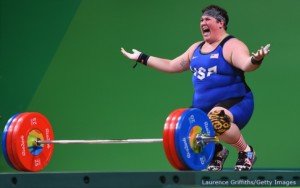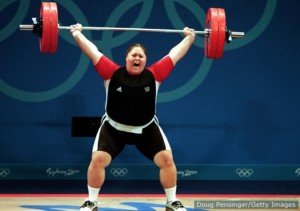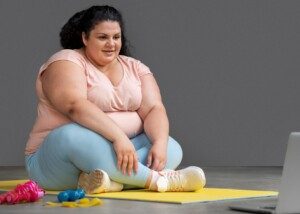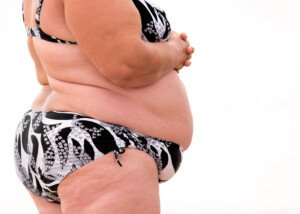Under what circumstances can a 300 pound woman be strong, fit and healthy? If she feels this way, is it necessarily true?
One might argue that Sarah Robles is strong, fit and healthy because, at over 300 pounds, she lifted 356 pounds in the clean-and-jerk weightlifting event at the 2016 Olympics.
One might insist that Cheryl Haworth, also over 300 pounds, is healthy and fit (at least at the time of competition) because at the 2000 Olympics she snatched 275 pounds.
These are certainly two extremely strong women — both tipping the scales at over 300 pounds. They seem to make the case for the fat acceptance and health at every size movements.
A fair question is what kind of shape their knees will be in when they’re 50 – not because of all the deep squatting required of their sport – but from weighing more than 300 pounds.
Supporters of HAES might argue that the lightweight competitive lifters have been known to suffer knee problems later in life.
But what’s worse? Knee damage in a 150 pound woman or one who weighs 300?
Knee damage from sport is bad enough without the additional insult of morbid obesity.
How will their hearts be functioning down the road?
No matter how strong a weightlifter is, the human body just isn’t designed to support 150 pounds of unnecessary fat.
Superstrong Weightlifters Do Not Represent Morbidly Obese Women
Athletes like Sarah Robles and Cheryl Haworth are exceptionally rare in a sea of morbidly obese women.
Like LeBron James and Michael Phelps, these female super athletes certainly have some “good genetics” going for them.
It’s too simplistic to say that “fat people are naturally strong.”
When I was a personal trainer, I never saw any potential for such enormous strength in any of my hefty female, or male, clients — though obese women new to strength training had an easier time with the leg press, seated chest press, lat pull-down and seated row when compared to thinner novice women.
Excelling in the sports of Olympic-style weightlifting and powerlifting requires certain body proportions – regardless of height and how much fat is in one’s body.
For example, arms that are short, relative to the athlete’s height, provide a huge advantage in transferring a heavy barbell from the floor, through the air and over their head.
If that same woman’s arms grew six inches longer, but everything else remained unchanged, her ability to get the barbell overhead from the floor would be a lot more difficult.
However, she might do very well in the deadlift, in which a barbell is picked up from the floor but brought only up to one’s hips.
Thigh bones that are much shorter than their torso is another mechanical advantage in performing these lifts.

Sarah Robles
These are women who are blessed with proportions very suitable to their specific lifts.
Other factors also influence strength, such as ratio of fast-twitch muscle fiber to slow-twitch, and structure of muscle tendon insertions.
Body positivity influencers and fat acceptance enthusiasts like to point out these VERY isolated cases of athleticism, genetics and great coaching and conclude that this kind of strength and apparent fitness applies to the general population of morbidly obese women.
“A woman can certainly be strong at 300 pounds, but fit and healthy, unlikely,” says Sarah Johnson, an RN and health ambassador for FamilyAssets, an online eldercare and senior living resource.
Johnson explains, “Healthy weights and BMIs are relative to a person’s age, height, gender, and other underlying health conditions and factors.
“But there is no combination of any of those variables — that I know of — which supports the suggestion that a 300 pound woman is healthy, or at least is on a path to sustained long-term health.”
One must wonder how many of these influencers do any strength training at all.
When it comes to being fit and strong at 300 pounds, we should NOT be talking about the general population of women, the so-called “Walmart fat.”
We should be talking about women such as Sarah Robles and Cheryl Haworth.

Cheryl Haworth
And even then, an astute observer can’t help but wonder how well these Olympic lifters would do running up a single flight of stairs, down a staircase or across a parking lot — especially once they retire.
We have to wonder what their doctors would advise once these athletes leave competition.
Very heavy competitive powerlifters and weightlifters should NOT be used as a yardstick by the body positive community as to how healthy and fit the average morbidly obese woman is!
If a 300 pound Instagram star insists she’s healthy, fit and strong, we must wonder how long she’d last shoveling snow.
Yes, we know there are thin women who’d drop from exhaustion after only five minutes of shoveling.
A strength training program will take care of that (hopefully she doesn’t smoke, which would in part explain the exhaustion).
A strength training regimen will also help the obese woman. BUT … a hundred pounds of extra fat will still be a hindrance to stamina and efficacy of movement. Weighing 150 pounds, on the other hand, would not be a hindrance!
Stop saying you’re fit and strong just because Sarah Robles can lift 356 pounds.
 FamilyAssets connects families with leading senior care providers using data and technology. Individuals can select goals and preferences to create a customized list of senior care options including assisted living, memory care and skilled nursing.
FamilyAssets connects families with leading senior care providers using data and technology. Individuals can select goals and preferences to create a customized list of senior care options including assisted living, memory care and skilled nursing.
 Lorra Garrick is a former personal trainer certified by the American Council on Exercise. At Bally Total Fitness she trained clients of all ages for fat loss, muscle building, fitness and improved health.
Lorra Garrick is a former personal trainer certified by the American Council on Exercise. At Bally Total Fitness she trained clients of all ages for fat loss, muscle building, fitness and improved health.
.










































